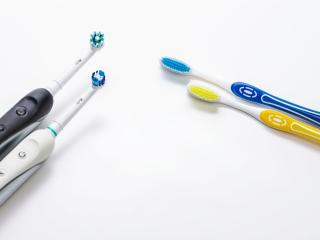Choosing the Right Toothbrush

3 min read
Choosing the right toothbrush and toothpaste is essential for maintaining good oral hygiene and preventing dental problems. With so many options available, it can be overwhelming to determine which products are best for your needs. Here’s a guide to help you make informed decisions when selecting your toothbrush and toothpaste.
By selecting the right toothbrush and toothpaste, you can ensure that your daily oral hygiene routine is effective in keeping your teeth and gums healthy. Invest in quality products that meet your needs and consult your dentist for further guidance. Your smile will thank you!
Choosing the Right Toothbrush
1. Manual vs. Electric Toothbrushes- Manual Toothbrushes: These are effective if used properly and are a cost-effective option. Look for a toothbrush with soft bristles to prevent damage to your gums and enamel.
- Electric Toothbrushes: These can be more effective at removing plaque and reducing gingivitis, especially for those who struggle with manual brushing techniques. They often come with features like timers and pressure sensors to ensure thorough cleaning.
2. Bristle Type
- Soft Bristles: Recommended for most people as they are gentle on the gums and enamel. They effectively clean teeth without causing damage.
- Medium or Hard Bristles: Generally not recommended as they can be too abrasive, leading to gum recession and enamel erosion.
3. Toothbrush Head Size and Shape
- Choose a toothbrush with a small, compact head that can easily reach all areas of your mouth, including the back teeth. A head with a rounded shape can help clean hard-to-reach areas more effectively.
4. Handle Design
- Opt for a toothbrush with a comfortable, non-slip grip. This can make it easier to hold and control the toothbrush, especially for children or those with limited dexterity.
Choosing the Right Toothpaste
1. Fluoride Content
- Fluoride: Look for toothpaste that contains fluoride, a mineral that helps strengthen tooth enamel and prevent cavities. Fluoride toothpaste is recommended for both children and adults.
2. Specific Dental Needs
- Sensitive Teeth: If you have sensitive teeth, choose a toothpaste formulated to reduce sensitivity. These toothpastes contain ingredients like potassium nitrate or stannous fluoride that help desensitize your teeth.
- Whitening: Whitening toothpastes can help remove surface stains and maintain a brighter smile. However, they may contain abrasive ingredients, so use them with caution if you have sensitive teeth or gums.
- Tartar Control: For those prone to tartar buildup, choose a toothpaste that contains ingredients to help prevent the formation of tartar.
3. Natural Ingredients
- If you prefer natural products, look for toothpaste that contains natural ingredients and is free from artificial flavors, colors, and preservatives. Ingredients like baking soda, aloe vera, and essential oils can be effective in maintaining oral health.
4. ADA Seal of Acceptance
- Ensure the toothpaste you choose has the American Dental Association (ADA) Seal of Acceptance. This seal indicates that the product has been tested and proven to be safe and effective for oral health.
Additional Tips
1. Replace Your Toothbrush Regularly
- Replace your toothbrush or toothbrush head every three to four months, or sooner if the bristles are frayed. A worn-out toothbrush is less effective at cleaning your teeth.
2. Consult Your Dentist
- Your dentist can provide personalized recommendations based on your specific dental needs and oral health condition. They can help you choose the right toothbrush and toothpaste to maintain optimal oral hygiene.
3. Consider Your Individual Needs
- Everyone’s oral health needs are different. Consider factors such as any dental conditions, preferences for natural products, and whether you need special care for sensitive teeth or whitening.
By selecting the right toothbrush and toothpaste, you can ensure that your daily oral hygiene routine is effective in keeping your teeth and gums healthy. Invest in quality products that meet your needs and consult your dentist for further guidance. Your smile will thank you!
